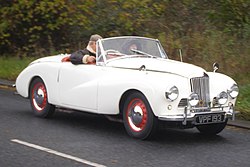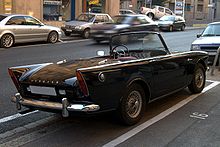Sunbeam Alpine
| Sunbeam Alpine | |
|---|---|
| Production period: | 1953-1955 1959-1968 |
| Class : | Sports car |
| Body versions : | Roadster |
| Successor: | Sunbeam New Rapier |
A number of sporty vehicles from the British Rootes Group were sold under the name Sunbeam Alpine .
Alpine Mark I / III
| Mark I / III | |
|---|---|
|
Sunbeam Alpine (1954) |
|
| Production period: | 1953-1955 |
| Body versions : | Roadster |
| Engines: |
Otto engine : 2.3 liters (51 kW) |
| Length: | 4280 mm |
| Width: | 1588 mm |
| Height: | |
| Wheelbase : | 2477 mm |
| Empty weight : | |
The first model was released in 1953 and was the first car to bear the sole name of Sunbeam again after the collapse of the STD group (Sunbeam, Talbot and Darracq ). The Alpine was derived from its predecessor, the Sunbeam-Talbot 90 , and was therefore called "Talbot-Alpine" in common parlance. In the beginning, a two-seater sports roadster was developed by the Sunbeam Talbot dealer George Hartwell in Bournemouth as a one-off for rally use, which began as a convertible in 1952. Presumably, it got its name from Norman Garrad of the factory's competition department, who was heavily involved in Sunbeam-Talbot's successes in the Alpine rallies of the early 1950s , using a branded sedan . The Alpine models Mark I and Mark III (there was never a Mark II) were handcrafted, like the convertible offered between 1953 and 1955 , of which 3,000 were built by the independent body manufacturer Thrupp & Maberly . There are probably only 200 of them left today. The car had a four-cylinder engine, but since it was built on a sedan chassis, it was always compromised and only stayed in production for two years.
Alpine Series I - V
| Series I – V | |
|---|---|
|
Sunbeam Alpine Series V (1967) |
|
| Production period: | 1959-1968 |
| Body versions : | Roadster |
| Engines: |
Petrol engines : 1.5–1.7 liters (54–93 kW) |
| Length: | 3937 mm |
| Width: | 1549 mm |
| Height: | 1295 mm |
| Wheelbase : | 2184 mm |
| Empty weight : | 1320 kg |
A second series of the Sunbeam Alpine was produced between 1959 and 1968.
The engineers Kenneth Howes and Jeff Crompton were commissioned in 1956 to redesign a sporty vehicle, which should primarily be aimed at the US market. The new car conceptually aimed at the niche that the MGA , Triumph TR3A and Austin-Healey 100 successfully occupied. The new Alpine was a compact two-seater roadster with an attractive body that looked like a scaled-down Ford Thunderbird from some angles . That was of course no wonder, because on the one hand the successful American design was also a model for other manufacturers (such as the Auto Union 1000 ), on the other hand, the Alpine engineer Ken Howes had worked for Ford for many years before joining the Rootes Group came.
Since the Rootes Group was very cautious with the development budget back in the 1950s, the new Alpine used numerous components that were already used in other models of the group. The floor pan and the internal structure of the superstructure, for example, came from the Hillman Husky II , while the drive technology was more or less unchanged from the Sunbeam Rapier . From this kit, four-cylinder engines with displacements between 1.5 liters and 1.725 liters were used, which were machined to different degrees. A manual four-speed gearbox with optional overdrive was used regularly to transmit power ; a three-stage Borg-Warner 35 automatic transmission was also offered in a single series .
In the course of 1958 some prototypes were made; one of them survived.
Series production of the Alpine began in 1959. In the following ten years, a total of five series were created, each of which differed from one another through considerable development steps. The vehicles of the first series and the first models of the second series were built at Burlington Carriage Company , a bodywork plant from Coventry , which was part of Bristol Siddeley Engines . Since the summer of 1962, however, production took place in Rootes' own facilities in Ryton-on-Dunsmore .
The individual series
Series I.
Series I vehicles were manufactured exclusively in Coventry from 1959 to 1960. They had sharply designed tail fins with a sharply sloping tailgate and were powered by a 1.5 liter four-cylinder engine that delivered 78 hp.
Series II
After the Series I had been in production for only 15 months, a second series appeared in the summer of 1960. The car received a four-cylinder enlarged to 1.6 liters, the output of which had increased to 80 hp while increasing the torque. Externally, the new model hardly differed from the first series. The base price for an Alpine Series II was £ 986 when it was launched.
Series III
In the spring of 1963 the third series of the Alpine was presented. For the first time, two versions were on offer: the well-known Roadster , now known as the Alpine Tourer , and a version with a fixed hardtop , which was named Alpine GT . The design of the Series II was adopted largely unchanged; There were changes mainly in the area of the interior, primarily with the seats. Both versions of the Alpine were powered by the 1.6-liter four-cylinder, which made 82 hp in the tourer and 77 hp in the GT. Series III was decidedly short-lived; after only nine months it was replaced by the Alpine Series IV.
Series IV
The Series IV presented in January 1964 brought (for the first time) a significant stylistic revision of the well-known model. Similar to other vehicles of the Rootes group, the conspicuous tail fins were removed and replaced by a vertical fender end with standing oval taillights. At the same time, the line of the trunk lid had been raised significantly, which significantly increased the trunk volume. The front section was essentially taken over; A special feature of the fourth series was a chrome-plated cross strut in the otherwise unchanged radiator grille. There were also modifications on the drive side: the well-known 1.6 liter four-cylinder (with 82 hp) remained unchanged in the program; however, a three-speed automatic from BorgWarner was now available for the first time . The division into a GT and a Tourer model that began with Series III ceased with the introduction of the fourth series; the Alpine was offered under a single name.
Series V
In the summer of 1965, the last modification of the Alpine theme appeared with the V series. It remained unchanged in the program for almost three years - an unusually long time for Rootes standards. Outwardly, the V series did not differ from the IV series models, but there was a noticeable upgrade on the drive side: the Alpine now received a 1.725 liter version of the in-house four-cylinder engine that delivered 92 hp. This made the car 98 mph, a veritable figure that surpassed all previous Alpine series. Nevertheless, the reputation of the Alpine Series V suffered from having (just barely) missed the prestigious 100 mph mark and thus lagging behind the MGB and Triumph TR4 / TR4A .
The automatic transmission optionally offered in Series IV was no longer available for Series V.
Production data
| model | construction time | Production facility | number of pieces |
|---|---|---|---|
| Series I | 1959-1960 | Bristol Siddeley Engines | 11,904 |
| Series II | 1960-1963 | Bristol Siddeley Engines and Ryton | 19,956 |
| Series III | 1963-1964 | Ryton | 5,863 |
| Series IV | 1964-1965 | Ryton | 12,406 |
| Series V | 1965-1968 | Ryton | 19,122 |
Derivatives
The Sunbeam Tiger
Between 1964 and 1967 Rootes offered a variant of the Alpine with an American eight-cylinder from Ford under the name Sunbeam Tiger . The Tiger Series I was based on the Alpine Series IV or V; the only 1967 manufactured Tiger II, which had a larger engine, was based on the Alpine Series V. All Tiger versions were manufactured by Jensen Motors .
The Sunbeam Harrington Alpine
Between 1961 and 1963, Thomas Harrington Coach Builders Ltd. from Sussex produced some hatchback versions based on the Sunbeam Alpine, which differed from one another by differing roof designs and were at least temporarily offered side by side. A total of almost 400 copies were made. There are also reports that some Sunbeam Tigers were subsequently redesigned by Harrington into hatchback coupes . Harrington's design concept was taken up in 1966 by the Triumph GT6 .
Sunbeam Alpine in motorsport
The Alpine was repeatedly used in motorsport in different versions. The Sunbeam Talbot team reported two modified Alpine Series IIs (with hardtop ) for the Le Mans 24-hour race in 1962. One vehicle was driven by Peter Harper and Peter Procter, another by Paddy Hopkirk and Peter Jopp. Harper and Procter completed 268 laps and finished 15 overall, 63 laps behind. valued; Hopkirk and Jopp, however, had to retire after 187 laps with a technical defect.
In addition, the Sunbeam Alpine was occasionally used in rallying and club races. One of the prototypes produced in 1958 was driven by the famous racing driver in British sedans , Bernard Unett.
Sunbeam Alpine in the film
- A blue Alpine Mark III Roadster can be seen in the film To Catch a Thief by Alfred Hitchcock in 1955, in which Cary Grant and Grace Kelly play the leading roles. A quick chase down the French Corniche takes place in this car driven by Grace Kelly .
- A red Alpine Series I is driven by Elizabeth Taylor in the 1960 film Telephone Butterfield 8 .
- A blue Alpine Series II is featured by Sean Connery in the first James Bond film, James Bond - 007 Chasing Dr. No (1962) driven.
- A red Alpine Series IV can be seen in the 1985 Arnold Schwarzenegger film Das Phantom Kommando . The car is destroyed there.
New Alpine
Rootes introduced the Arrow model series in 1967 , which was mainly distributed in the four- and five-door versions Hillman Hunter , Singer Vogue and Humber Scepter . There was also a coupé version, the distribution of which was reserved for the Sunbeam brand. In 1967 the model called Sunbeam Rapier began to be sold . In 1969, the Rapier was given a cheaper, slightly slower and more economical version - still a sporty model - for which the name Alpine was used. All models had the 1725 cm 3 engine of the group with a crankshaft with five bearings. The simpler Alpine had a single Stromberg CD 150 carburetor while the Rapier had two. The fast Rapier H 120 had two Weber 40 DCOE carburettors. In 1975, a year before the New Rapier, the New Alpine was discontinued without replacement.
Chrysler / Talbot use of the name
The name Alpine was adopted in 1976 by Chrysler , the then owner of the Rootes Group, for a car that had nothing to do with the Sunbeam Alpine: the version of the Simca 1307 for the British market, a family car with a tailgate developed in France . The car was initially called Chrysler Alpine and then finally Talbot Alpine after Chrysler Europe was taken over by Peugeot in 1978 .
literature
- Graham Robson: The Cars of the Rootes Group , London 2007, ISBN 978-1-903088-29-6






